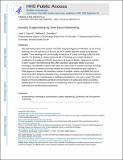| dc.contributor.author | Papa, Louis John | |
| dc.contributor.author | Shoulders, Matthew D. | |
| dc.date.accessioned | 2021-01-19T20:30:09Z | |
| dc.date.available | 2021-01-19T20:30:09Z | |
| dc.date.issued | 2019-09 | |
| dc.identifier.issn | 2160-4762 | |
| dc.identifier.uri | https://hdl.handle.net/1721.1/129451 | |
| dc.description.abstract | Recombineering inserts PCR products into DNA using homologous recombination. A pair of short homology arms (50 base pairs) on the ends of a PCR cassette target the cassette to its intended location. These homology arms can be easily introduced as 5' primer overhangs during the PCR reaction. The flexibility to choose almost any pair of homology arms enables the precise modification of virtually any DNA for purposes of sequence deletion, replacement, insertion, or point mutation. Recombineering often offers significant advantages relative to previous homologous recombination methods that require the construction of cassettes with large homology arms, and relative to traditional cloning methods that become intractable for large plasmids or DNA sequences. However, the tremendous number of variables, options, and pitfalls that can be encountered when designing and performing a recombineering protocol for the first time introduce barriers that can make recombineering a challenging technique for new users to adopt. This article focuses on three recombineering protocols we have found to be particularly robust, providing a detailed guide for choosing the simplest recombineering method for a given application and for performing and troubleshooting experiments. | en_US |
| dc.description.sponsorship | NIH Director’s New Innovator Award (Grant 1DP2GM119162) | en_US |
| dc.description.sponsorship | NIAMS (Grant R01AR071443) | en_US |
| dc.description.sponsorship | National Science Foundation Graduate Research Fellowships (Grant No. 1122374) | en_US |
| dc.language.iso | en | |
| dc.publisher | Wiley | en_US |
| dc.relation.isversionof | 10.1002/CPCH.70 | en_US |
| dc.rights | Creative Commons Attribution-Noncommercial-Share Alike | en_US |
| dc.rights.uri | http://creativecommons.org/licenses/by-nc-sa/4.0/ | en_US |
| dc.source | Prof. Shoulders via Ye Li | en_US |
| dc.title | Genetic Engineering by DNA Recombineering | en_US |
| dc.type | Article | en_US |
| dc.identifier.citation | Papa, Louis John and Matthew D. Shoulders. "Genetic Engineering by DNA Recombineering." Current Protocols in Chemical Biology 11, 3 (September 2019): e70 doi 10.1002/CPCH.70 ©2019 Author(s) | en_US |
| dc.contributor.department | Massachusetts Institute of Technology. Department of Chemistry | |
| dc.relation.journal | Current Protocols in Chemical Biology | en_US |
| dc.eprint.version | Author's final manuscript | en_US |
| dc.type.uri | http://purl.org/eprint/type/JournalArticle | en_US |
| eprint.status | http://purl.org/eprint/status/PeerReviewed | en_US |
| dc.date.updated | 2020-10-14T16:32:19Z | |
| dspace.orderedauthors | Papa, LJ; Shoulders, MD | en_US |
| dspace.date.submission | 2020-10-14T16:32:23Z | |
| mit.journal.volume | 11 | en_US |
| mit.journal.issue | 3 | en_US |
| mit.license | OPEN_ACCESS_POLICY | |
| mit.metadata.status | Complete | |
